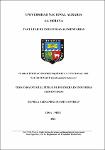Mostrar el registro sencillo del ítem
Caracterización fisicoquímica y funcional del Sachatomate (Cyphomandra betacea)
| dc.contributor.advisor | Condezo Hoyos, Luis Alberto | |
| dc.contributor.advisor | Cortés Avendaño, Paola Marlene | |
| dc.contributor.author | Mayhua Esteban, Daniela Alexandra | |
| dc.date.accessioned | 2022-11-08T23:25:08Z | |
| dc.date.available | 2022-11-08T23:25:08Z | |
| dc.date.issued | 2022 | |
| dc.identifier.uri | https://hdl.handle.net/20.500.12996/5497 | |
| dc.description | Universidad Nacional Agraria La Molina. Facultad de Industrias Alimentarias. Departamento Académico de Ingeniería de Alimentos y Productos Agropecuarios | es_PE |
| dc.description.abstract | En este trabajo de investigación se realizó la caracterización fisicoquímica y funcional del sachatomate (Cyphomandra betacea) para el desarrollo de productos en el mercado de alimentos funcionales a partir de las partes del fruto como la cáscara, semillas y pulpa procedentes de los departamentos de Huánuco y Cajamarca. Se evaluó para cada parte del fruto: el contenido de carotenoides totales, compuestos fenólicos extractables y total (QUENCHER), flavonoides totales, capacidad antioxidante extractable y total (QUENCHER), la actividad antimicrobiana frente a E. coli ATCC® 25922TM y S. aureus ATCC® 25923TM, y la actividad prebiótica usando Lactobacillus plantarum 299v y Lactobacillus rhamnosus GG. Los resultados revelaron que la cáscara poseía un mayor contenido de carotenoides que las semillas y pulpa, un mayor contenido de compuestos fenólicos extractables, capacidad antioxidante extractable y total (QUENCHER) que las semillas seguido que la pulpa, y un mayor contenido de compuestos fenólicos total (QUENCHER), flavonoides que las semillas y pulpa. Además, la cáscara demostró una mayor actividad antimicrobiana frente E. coli y S. aureus, seguido por las semillas y luego la pulpa procedente de Cajamarca. Todos los extractos mostraron actividad prebiótica frente a L. rhamnosus y L. plantarum. A partir de los resultados del estudio actual, se puede concluir que, entre las diversas partes de la fruta del sachatomate, la cáscara tiene la actividad antioxidante y antimicrobiana más alta, mientras que la pulpa tiene la menor. Las cáscaras y las semillas no sólo son potentes en sus efectos antioxidantes y antimicrobianos con niveles apreciables de compuestos fenólicos en relación con las otras partes, sino que también poseen actividad prebiótica sobre el crecimiento de dos bacterias probióticas acidolácticas. En general, las muestras estudiadas resultan ser una buena fuente de antioxidantes sobre todo de compuestos fenólicos, cuyo uso podría ser adecuado en la formulación de alimentos funcionales. | es_PE |
| dc.description.abstract | In this research work, the physicochemical and functional characterization of sachatomate (Cyphomandra betacea) was carried out for the development of products in the functional food market from parts of the fruit such as peel, seeds and pulp from the departments of Huánuco and Cajamarca. The following were evaluated for each part of the fruit: the content of total carotenoids, extractable and total phenolic compounds (QUENCHER), total flavonoids, extractable and total antioxidant capacity (QUENCHER), antimicrobial activity against E. coli ATCC® 25922TM and S. aureus ATCC® 25923TM, and prebiotic activity using Lactobacillus plantarum 299v and Lactobacillus rhamnosus GG. The results revealed that the peel had a higher carotenoid content than seeds and pulp, a higher content of extractable phenolic compounds, extractable and total antioxidant capacity (QUENCHER) than seeds followed by pulp, and a higher content of total phenolic compounds (QUENCHER), flavonoids than seeds and pulp. In addition, the peel showed higher antimicrobial activity against E. coli and S. aureus, followed by the seeds and then the pulp from Cajamarca. All extracts showed prebiotic activity against L. rhamnosus and L. plantarum. From the results of the current study, it can be concluded that, among the various parts of the sachatomate fruit, the peel has the highest antioxidant and antimicrobial activity, while the pulp has the lowest. Not only are the peels and seeds potent in their antioxidant and antimicrobial effects with appreciable levels of phenolic compounds relative to the other parts, but they also possess prebiotic activity on the growth of two probiotic acid lactic acid bacteria. In general, the samples studied prove to be a good source of antioxidants, especially phenolic compounds, whose use could be appropriate in the formulation of functional foods. | en_US |
| dc.format | application/pdf | en_US |
| dc.language.iso | spa | es_PE |
| dc.publisher | Universidad Nacional Agraria La Molina | es_PE |
| dc.rights | info:eu-repo/semantics/embargoedAccess | en_US |
| dc.rights.uri | https://creativecommons.org/licenses/by-nc-nd/4.0/ | * |
| dc.subject | Sachatomate | es_PE |
| dc.subject | Variedades | es_PE |
| dc.subject | Propiedades fisicoquímicas | es_PE |
| dc.subject | Propiedades reológicas | es_PE |
| dc.subject | Evaluación | es_PE |
| dc.subject | Perú | es_PE |
| dc.title | Caracterización fisicoquímica y funcional del Sachatomate (Cyphomandra betacea) | es_PE |
| dc.type | info:eu-repo/semantics/bachelorThesis | en_US |
| thesis.degree.discipline | Industrias Alimentarias | es_PE |
| thesis.degree.grantor | Universidad Nacional Agraria La Molina. Facultad de Industrias Alimentarias | es_PE |
| thesis.degree.name | Ingeniero en Industrias Alimentarias | es_PE |
| dc.subject.ocde | https://purl.org/pe-repo/ocde/ford#2.11.01 | es_PE |
| renati.author.dni | 73084921 | es_PE |
| dc.publisher.country | PE | es_PE |
| dc.type.version | info:eu-repo/semantics/publishedVersion | en_US |
| dc.date.embargoEnd | 2024-08-05 | |
| renati.advisor.orcid | https://orcid.org/0000-0001-8470-0976 | es_PE |
| renati.advisor.orcid | https://orcid.org/0000-0001-7622-8894 | |
| renati.advisor.dni | 09606892 | es_PE |
| renati.advisor.dni | 42176313 | |
| renati.type | https://purl.org/pe-repo/renati/type#tesis | es_PE |
| renati.level | https://purl.org/pe-repo/renati/level#bachiller | es_PE |
| renati.discipline | 721026 | es_PE |
| renati.juror | Silva Jaimes, Marcial I. | |
| renati.juror | Glorio Paulet, Patricia | |
| renati.juror | Aguilar Galvez, Ana C. |
Ficheros en el ítem
Este ítem aparece en la(s) siguiente(s) colección(ones)
-
IAL-IA Tesis [177]





